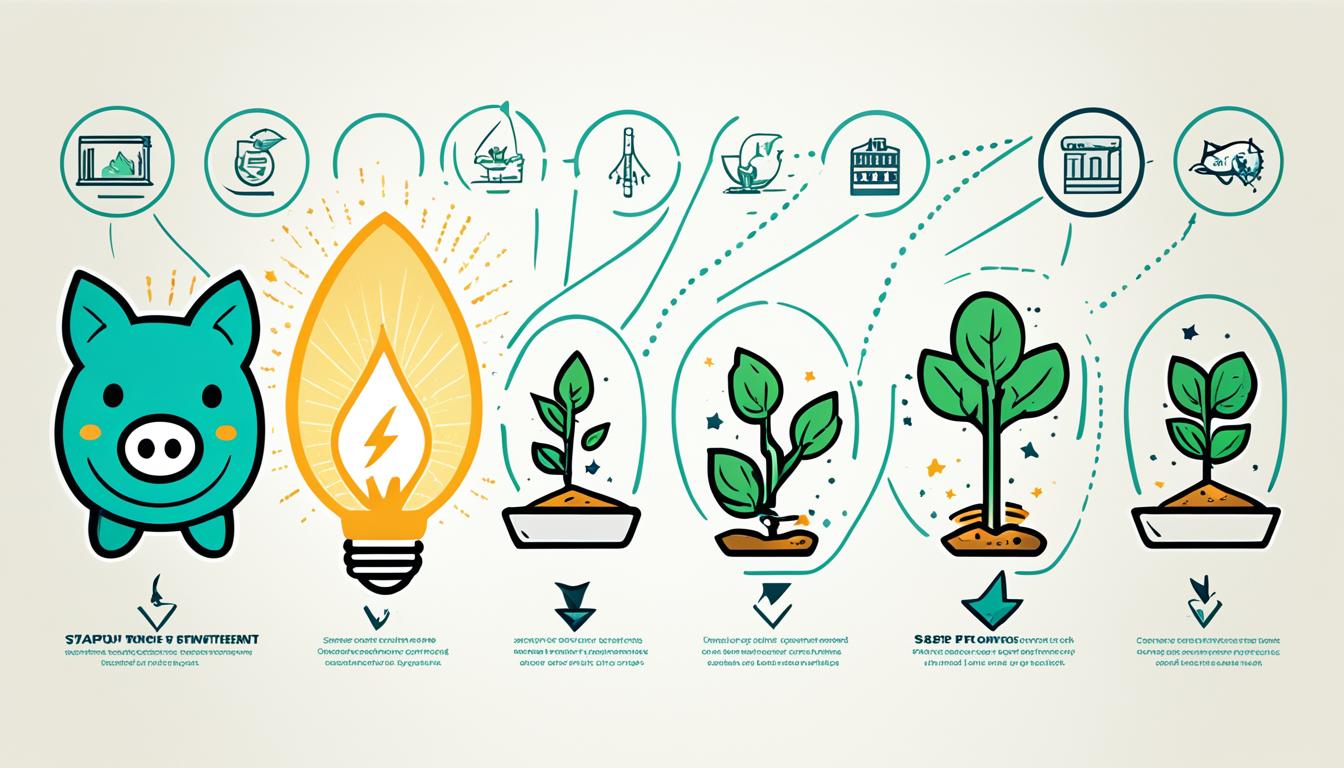Did you realize that over 38% of entrepreneurs receive funding from friends and family? This highlights the significance of funding for startups. Annually, they secure more than $60 billion from personal connections. Additionally, crowdfunding platforms such as Kickstarter and Indiegogo have revolutionized how entrepreneurs access funds.
If you plan to start or grow a business, knowing your funding options is key. This guide is here for you, whether you’re new or experienced in business. It will show you how to get ready for funding, understand different kinds of funding, and succeed in getting the money you need.
Key Takeaways
- 38% of entrepreneurs rely on friends and family for startup funding.
- Over $60 billion raised annually through personal networks for startups.
- Crowdfunding platforms have opened new avenues for entrepreneurs.
- Understanding diverse funding sources is crucial for any startup.
- A comprehensive business plan is vital in securing funding.
- Networking can yield valuable insights and opportunities in funding.
Understanding the Importance of Startup Funding
Getting startup funding is a key step in your business journey. It’s crucial because it turns bright ideas into real businesses. With enough funding, startups can overcome big obstacles on their way to success.
Funding lets you develop your products and enter the market. But remember, a startup might get turned down many times before getting a yes. Knowing about funding early helps build a strong business base.
Funding also means getting advice, mentorship, and connections. These elements can help your startup grow and last. For example, early funding can range from $150,000 to $1,000,000. This money helps with initial costs and making prototypes.
It’s important to know what each funding stage offers. Seed funding can be between $1,000,000 and $5,000,000. It helps startups move to bigger funding rounds. Series A funding needs a developed product and steady sales. Amounts range from $15,000,000 to $20,000,000. This funding is vital for your business operations. A well-planned funding strategy is key.
- Initial rounds of funding typically include:
- Pre-seed: $10,000 to $100,000
- Seed: A few thousand dollars to several million
- Series A: $1 million to $15 million
- Series B: $7 million to $12 million
- Series C: $30 million to several billion
With enough funding, your startup can grow and compete better. Understanding funding can boost your chance of success in the business world.
Types of Startup Funding Available
It’s critical for entrepreneurs to know the different types of startup funding. There are two main categories: equity investment and debt funding. Each serves different purposes and offers various options.
Equity investment means selling part of your company for capital. It happens during several rounds, like Series A, B, C, D, and even E. For example, Series A funding is usually between $2 million to $15 million. Series B funding ranges from $10 million to $60 million. Series C companies often raise $20 million to $100 million. The high valuations of these rounds make them both appealing and competitive.
Debt funding is when you borrow money and pay it back with interest. Startups often choose small business loans, including SBA loans or business credit cards with a 0% introductory APR. This option helps you keep ownership while getting the funds you need.
Startups might also look at funding options like crowdfunding. It uses the power of many people online to raise money, from friends and family to potential customers. Crowdfunding is great for building community support while raising funds.

| Funding Type | Range/Amount | Valuation | Purpose |
|---|---|---|---|
| Series A | $2M – $15M | $10M – $15M | Scaling product and market reach |
| Series B | $10M – $60M | $30M – $60M | Market capture and operational scaling |
| Series C | $20M – $100M | $100M – $120M | Expansion and product diversification |
| Debt Funding | Varies | N/A | Maintaining ownership while raising funds |
| Crowdfunding | Varies | N/A | Community engagement and funding |
Knowing these funding options helps you decide the best path for your business. The right choice is key to success and fulfilling your entrepreneurial dream.
How to Apply for Startup Funding
Applying for startup funding takes a structured approach. It includes essential documentation and a strong business story. Knowing the steps can increase your chances of getting the needed funds for your venture.
Gather Essential Documents for Funding Applications
Begin by gathering your application documents for startup funding. You will need:
- Financial statements showing your current financial health.
- Legal permits and licenses for your industry.
- Personal identification to prove your identity and trustworthiness.
These documents prove your business’s viability and stability. Make sure they are accurate and well-organized. This will help show your professionalism.
Craft a Compelling Business Plan
Next, focus on creating a strong business plan. This plan is at the heart of your funding application. Be sure to include:
- A clear business model description.
- Detailed market analysis to know your competition.
- Revenue projections to show potential earnings.
- Your unique value proposition to stand out.
Investors want clear, detailed plans. A well-made plan can greatly improve your chances of getting startup funding.

Bootstrapping Your Startup: Self-Funding Strategies
Starting your business with bootstrapping means using your own money. This way, you don’t rely much on outsiders and keep full control. By spending your own money wisely, you can grow slowly but surely. This method also encourages creative and cost-effective ways of doing business.
Explore Personal Funding Options
It’s important to look at your own money sources first for your business. You might use savings, do extra jobs, or sell things you don’t need.
- Utilizing savings accumulated over time
- Taking on freelance work or part-time jobs to generate extra income
- Leveraging assets such as selling unwanted items or renting property
These steps help you raise money without losing any ownership. Remember, growing on your own funds might be slow. But it keeps you in charge and focused.
Building Your Business Slowly
Growth should be steady in bootstrapping. Keep your spending low, check your profits, and consider hiring freelancers to save money.
- Adopting lean operations that maximize value for customers
- Validating your business idea with a Minimum Viable Product (MVP)
- Prioritizing revenue-generating activities and strategic hiring
- Forming partnerships and bartering to increase capabilities without raising costs
Staying financially careful and focusing on your customers will build a strong base. With emphasis on making money and keeping costs down, your business can grow. Eventually, this might even attract investors.

Leveraging Friends and Family for Initial Funds
When starting up, friends and family are key for initial money. A 2014 survey by the Kauffman Foundation found around 40% of startup funds come from them. This money usually has less financial stress, offering low or no interest rates.
This kind of support typically brings in about $23,000 per person. Funding rounds can reach between $50,000 and $500,000. Keeping these relationships healthy is key. It’s vital to have clear deals and talk openly to avoid issues. Mixing business with personal ties can get tricky. Turning these investments into standard loans with fair interest can help keep things clear.
Updating your friends and family regularly makes managing expectations easier. It also keeps the trust and transparency intact. Experienced folks in your circle can offer extra support. They provide mentorship and advice when things get tough.
Though friends and family funding can be very helpful, relying on it too much may be a problem. It can mess up the company’s ownership structure and affect future fundraising. Founders often give up 10-15% of their company this way. In contrast, seed rounds may require giving away 20-30%. Despite the drawbacks, support from friends and family is an excellent first step. It should be seen as a building block, not the only source of funds.

| Aspect | Friends and Family Funding | Seed Rounds |
|---|---|---|
| Typical Amount Raised | $50,000 – $500,000 | $1,000,000 – $3,000,000 |
| Equity Given Up | 10-15% | 20-30% |
| Average Individual Investment | $23,000 | Higher amounts from professional investors |
| Return on Investment Probability | High chance of zero return | Varied based on business success |
| Investment Liquidity | Returns usually take 7-15+ years | Similar investment horizon |
Utilizing Crowdfunding Platforms Effectively
Crowdfunding platforms are great for startups looking to raise money. They depend on small donations from many people. Knowing how to use these platforms can greatly help your fundraising. It’s vital to choose a crowdfunding model that fits your business and product.
Choosing the Right Crowdfunding Model
There are different crowdfunding options to consider:
- Donation-based crowdfunding: Here, people give money without expecting anything back.
- Rewards-based crowdfunding: In this model, donors get gifts or products for their donation.
- Equity-based crowdfunding: Companies give away a piece of their business for funding, which can lead to big rewards.
- Debt-based crowdfunding: The money is borrowed and paid back with interest, like a loan.
Platforms like Kickstarter and Indiegogo are top choices, with millions of users. For example, Kickstarter has over 4 million donors. They’ve helped fund over 350,000 projects. Choosing the right model is key to hitting your fundraising goals.
Marketing Your Crowdfunding Campaign
Good marketing is key to a successful crowdfunding campaign. Stories, videos, and strong messages pull in potential donors. Using social media and online marketing can spread the word wider. This increases your chances of raising more money.
It’s also crucial to know about the costs of using these platforms. For example, Kickstarter takes a 5% fee if you reach your funding goal. Indiegogo has different funding options to consider. This knowledge will help you budget well and set achievable goals.

Seeking Venture Capital: A Comprehensive Overview
Venture capital is key for many startups‘ growth. By finding the right VC partners, you can boost your business expansion. Startups with VC funding grow faster than those without.
It’s important to understand how VC firms operate. They look for businesses at different stages but with high market potential and strong teams. They do thorough checks on financials and business plans. Expect to provide detailed financial forecasts.
Your first step is a killer elevator pitch to attract investors. It must quickly explain your startup’s solution and market potential. Prepare a pitch deck with 10 to 20 slides as well.

Choosing venture capitalists that share your values is essential. It helps in getting funds and finding partners who back your growth vision. Introduce yourself through industry connections to begin.
| Criteria for VC Funding | Details |
|---|---|
| Market Opportunity | Large potential market, with substantial demand for the product or service. |
| Competitive Edge | Unique qualities or advantages over competitors, providing a solid foundation for growth. |
| Management Team | A strong, experienced management team capable of executing the business plan. |
| Solid Business Plan | A detailed plan illustrating how the funding will be used and projected outcomes. |
| Proven Track Record | Evidence of past successes or milestones achieved within the industry. |
Finding venture capital is competitive but full of growth chances. Prepare well and connect with the right VC firms. Doing this, you prepare your startup for success.
Preparing for Your First Pitch to Investors
Getting ready to pitch to investors is crucial for every entrepreneur wanting to get funding and make important connections. It’s important to not just talk about what your business does. You also need to show the market potential and what progress you’ve made in an interesting way.
Practice your pitch to make it perfect within a 10 to 20-minute slot. Your elevator pitch should quickly cover the problem you’re solving, how you’re doing it, and why it matters, all in about 30 seconds. Don’t forget to include data, financial goals, and how you plan to use the funding to grow.
Knowing your competition is key. Investors want to understand where you stand in the market. Point out the total size of the market you’re targeting with actual numbers. Talk about any risks, like legal issues, and how you plan to deal with them.

Explain your marketing plan clearly. Tell them how you will attract customers and introduce your product. Share your financial plans, how you’re going to make money, and your future goals. Also, describe how you plan to exit, whether by selling the company, going public, or other ways.
Create a set of 10 to 20 slides for your pitch that look good and help tell your story. This helps people see what you’re saying and shows off your team’s skills. Practicing your pitch with mentors or friends can really help you improve.
By including all of these parts, you make your pitch more powerful. This improves your chances of getting the investment you need.
Due Diligence: What Investors Expect
Understanding due diligence is key for startups seeking funding. It lets investors check a startup’s business approach, market position, and success chances. Knowing what happens in this part can greatly affect the funding outcome. Startups must get ready to meet what investors look for.
Understanding the Due Diligence Process
The due diligence phase usually takes from 2-3 weeks to 2 months. Venture capitalists focus on important parts including:
- Product or Service
- Market
- People
- Financials
- Equity Structure
- Risk
During evaluation, investors check for scalability, how you protect your idea, and your product’s cost effectiveness. They like seeing strong sales growth, good profit margins, and smart money handling. If these areas look good, they might move forward with more serious talks.
Preparing for Investor Questions
Expect investors to ask about:
- Your product’s unique features
- Your financial growth strategy
- Your team’s unity
Ready answers can build trust with investors. Also, having your info organized in due diligence binders speeds up the review. A clear point of contact keeps your message consistent, which builds more trust.

The feedback from due diligence can help improve your strategy for future investors. Remember, in venture capital, only one in a hundred pitches gets funded. Knowing this process can up your chances and give insights for your startup’s future.
| Due Diligence Aspects | Investor Focus | Common Concerns |
|---|---|---|
| Product or Service | Scalability, IP protection, Unit margins | Intellectual property issues |
| Financials | High revenue growth, Good cash management | External stakeholder reviews |
| Team | Team cohesiveness | Communication inconsistencies |
Conclusion
Getting money for your startup is tough, but knowing the different ways to fund it is key. This guide shows many types of funding. From angel investors early on to venture capital in later stages. Each one is crucial for a startup’s growth. The right preparation and pitch can really help in getting that support.
Building a strong pitch and good paperwork is vital. It shows off what your startup can do. Crowdfunding platforms are also powerful. They check if people want what you’re offering while helping you raise money. By using these tools and talking well with potential investors, you can overcome funding challenges and make your dream a reality.
A successful funding journey needs a smart strategy that looks at all the funding angles. This guide helps you talk to investors and boost your startup. Remember, every great startup started with a simple idea. With the right backing and tools, your idea can grow into something amazing.









